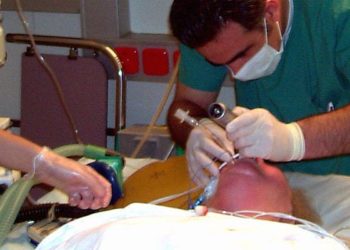Atropine plus propofol similar to atropine plus atracurium and sufentanil for non-emergent intubation in neonates
1. In this randomized controlled trial, the frequency of prolonged desaturation during neonatal, nonemergent intubation was similar between atropine plus propofol compared to atropine plus atracurium and sufentanil.
2. The process of intubation with atropine-propofol took longer than intubation with atropine-atracurium-sufentanil.
Evidence Rating Level: 1 (Excellent)
Study Rundown: Neonates requiring nonemergent intubation should receive premedication, as painful experiences in the neonatal period have been associated with poor neurodevelopmental outcomes. However, the optimal combination of medications has yet to be determined. In this randomized controlled trial, it was found that using a combination of a vagolytic (atropine) plus propofol versus atropine plus a rapid-onset, short-acting opioid (sufentanil) and a short-acting muscle relaxant (atracurium) showed no difference in prolonged desaturation during nonemergent, neonatal intubation. However, the duration of the intubation procedure was significantly longer for atropine-propofol compared to atropine-atracurium-sufentanil. There was no difference in the number of intubation attempts.
Though these results suggest these two interventions are similar, the study did not reach its target sample size based on preliminary power analyses, and thus there is a strong possibility that the study was underpowered to detect a significant difference in the primary outcome. In addition, the generalizability for these results is limited to nasotracheal intubation, and it is unclear how reflective these results are for oropharyngeal intubation. Overall, there may still be a clinically significant difference between these sedative strategies as the limitations of this study preclude a definitive conclusion.
Click to read the study, published in JAMA
Relevant Reading: Propofol versus midazolam for intubating preterm neonates: a randomized controlled trial
In-Depth [randomized controlled trial]: This multicenter, double-blind, randomized controlled trial with parallel groups randomized 173 neonates requiring nonemergency intubation between 2012-2016 in 6 neonatal intensive care units (NICU) in France. 89 neonates were randomized to the atropine-propofol group while 82 were randomized into the atropine-atracurium-sufentanil group. Neonates were included if they were in the NICU, had a corrected postmenstrual age of less than 45 weeks, intravenous access, and required non-emergent intubation. Exclusion criteria included sedatives or anesthetic administration in the prior 24 hours, hemodynamic failure, capillary refill >3 seconds, upper airway malformation, emergent intubation, being enrolled in another clinical trial, and contraindication to the study drugs.
The primary outcome was prolonged desaturation, defined as a SpO2 <80% for 60 seconds from the administration of the first drug to the completion of intubation. There was no significant difference between the groups in the incidence of prolonged desaturation (adjusted risk difference -6.4%; CI95 -21.0 to 8.1). The duration of the intubation procedure was significantly longer with atropine-propofol compared to atropine-atracurium-sufentanil (ARD 1.7 mins; CI95 0.1-3.3 mins). The median time to spontaneous respiration recovery was 14 minutes (IQR 8-34 mins) for the atropine-propofol cohort as compared to 33 minutes (IQR 15-56 mins) for the atropine-atracurium-sufentanil cohort (p = 0.002). There were significant differences between the two groups in median heart rates (-10.1 bpm; CI95 -17.3 to -2.9) and mean arterial pressure (-5.8 mmHg; CI95 -8.8 to -2.8). There were no differences in post-intubation head ultrasounds at 7 days between the two groups (ARD 1.2; CI95 -13.1 to 15.5).
Image: PD
©2018 2 Minute Medicine, Inc. All rights reserved. No works may be reproduced without expressed written consent from 2 Minute Medicine, Inc. Inquire about licensing here. No article should be construed as medical advice and is not intended as such by the authors or by 2 Minute Medicine, Inc.







